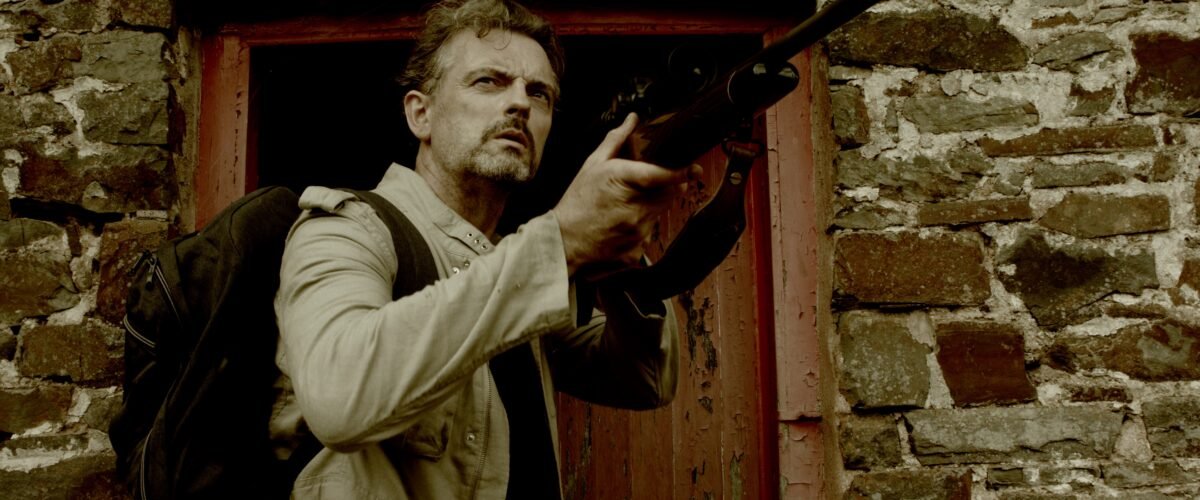ALIVE adds nothing new to the zombie genre
Alive
Directed and Written by David Marantz
Starring: Ellen Hillman, Kian Pritchard, Neil Sheffield
Runtime: 1 hour 28 minutes
Available digitally January 31
by Joe Carlough, Staff Writer
I’ll watch just about anything with zombies, from big-budget Hollywood affairs to low-budget passion projects to no-budget filmmakers in their backyards with iPhones. Alive (2023), a new flick picked up for digital release by Gravitas Ventures and the feature film debut for writer/director David Marantz, falls more between the second and third categories. A lo-fi love letter to the zombie films that have come before it, Alive never strays too far off the beaten path and only attempts a break in genre convention once it’s already a little too late in the film to make a meaningful impact.
Alive follows the trio of teen Helen, her boyfriend Kevin, and her little brother Barney as they traverse a zombie-infested countryside, looking for the island sanctuary that may be their salvation. Pushing them ever forward is Barney’s infection, which edges him closer to full-blown zombie with each passing day, staved off only by consumption of raw meat. They happen upon lone-wolf survivor Dan, who grudgingly takes them in, hoping they don’t uncover the secret in his attic while genuinely trying to help them on their journey.
From the infected child who must be protected to the friendly-at-first religious cult of dangerous fanatics to the loner who seemingly only knows self-preservation until a higher calling to protect others activates something inside of him, Alive can’t seem to shake the weight of the predecessors who paved the way for its arrival. Something about the movie felt more like an episode of Z Nation than a feature-length film, like there were pieces of storyline that I was missing. There was an aimlessness to some of the action and dialogue that spoke to letting a story unfold over an entire season instead of just one film. Alive follows a fairly common zombie narrative arc—get to a safe place while avoiding infection and the dangerous other humans—while skimping on the details. The characters’ lives prior to the viral spread feel inconsequential; as such, it was hard to form a bond with any of them or to really mind when something bad came their way.
I also question the decision to mute the colors so heavily. I tend to look for more reasons for a film to stand out from the pack, and the lush look of the forests and rivers around Dan’s homestead could have made for a brilliant backdrop to such a bleak story. I think about how strong the character of the forest was in Les Affames (2017), how effective the darkness was in It Comes at Night (2017). I think this was a missed opportunity to add character to the film, to juxtapose the dreary state of the zombies against a thriving natural landscape. By far the greatest transgression, though, is the title. Hot on the heels of South Korea’s excellent zombie survival hit #Alive (2020) and battling against so many other films by the same name, Alive feels dead on arrival.
There are many points to recommend the movie, though. It was well-paced and made good use of its settings: a lonely homestead near the woods, an empty school, a church basement. I thought Neil Sheffield was commendable as survivalist Dan, and Ellen Hillman worked admirably to bring Helen to life. I liked how the zombies snarled like crocodiles; it was an interesting take on the zombie moan. The surprising actions of the zombies towards the end—no spoilers, I swear!—made me wish the film began during the last ten minutes and followed that story instead.
All in all, Alive feels a bit more like a first draft than a finished product. Maybe they didn’t leave enough meat on the bones, or maybe the meat wasn’t there in the first place, but the story could have used more time to marinate. With simple characters and simpler action, watching Alive is not a bad way to pass a sleepy afternoon, but I wouldn’t plan a movie night around it.

